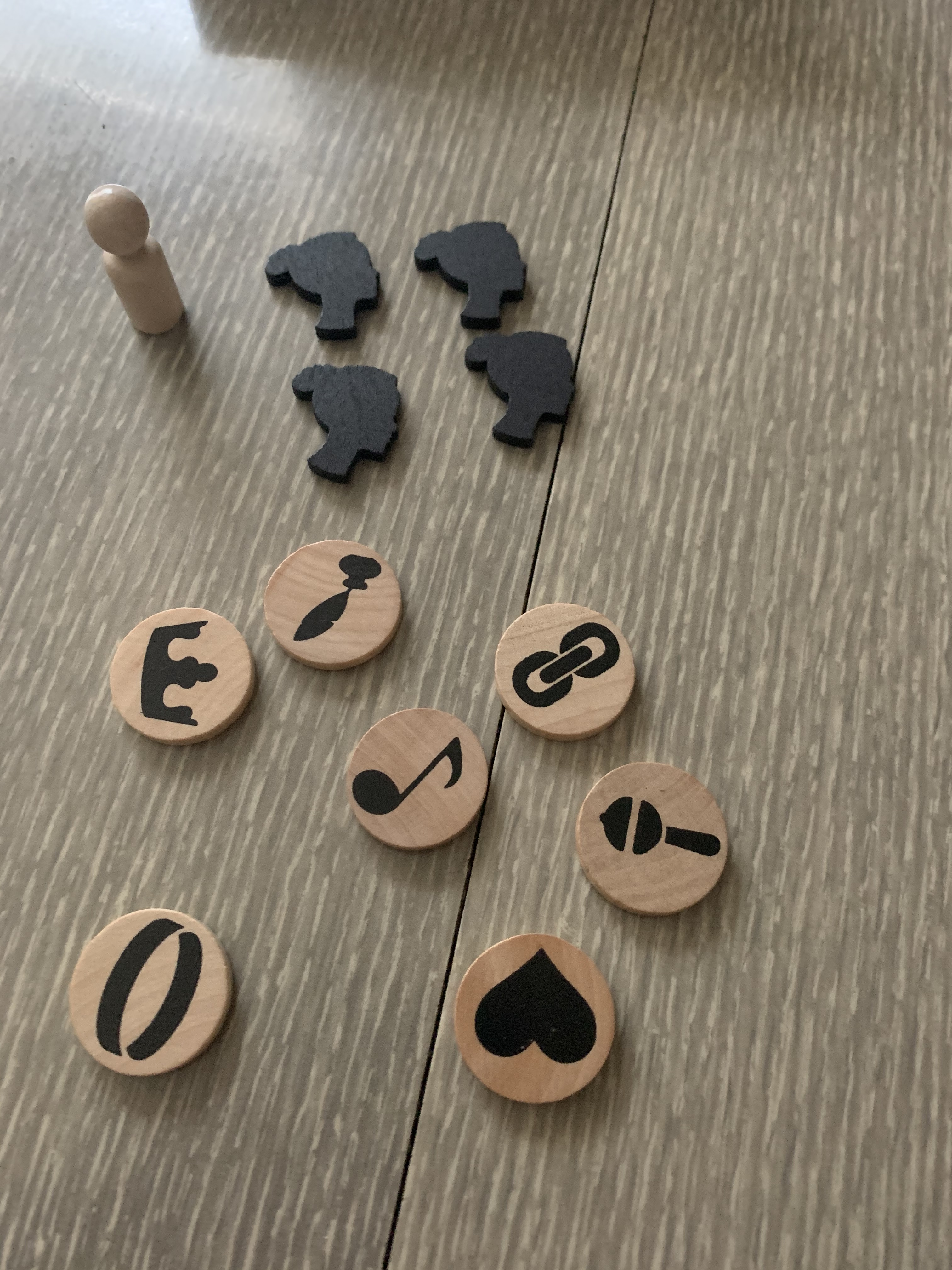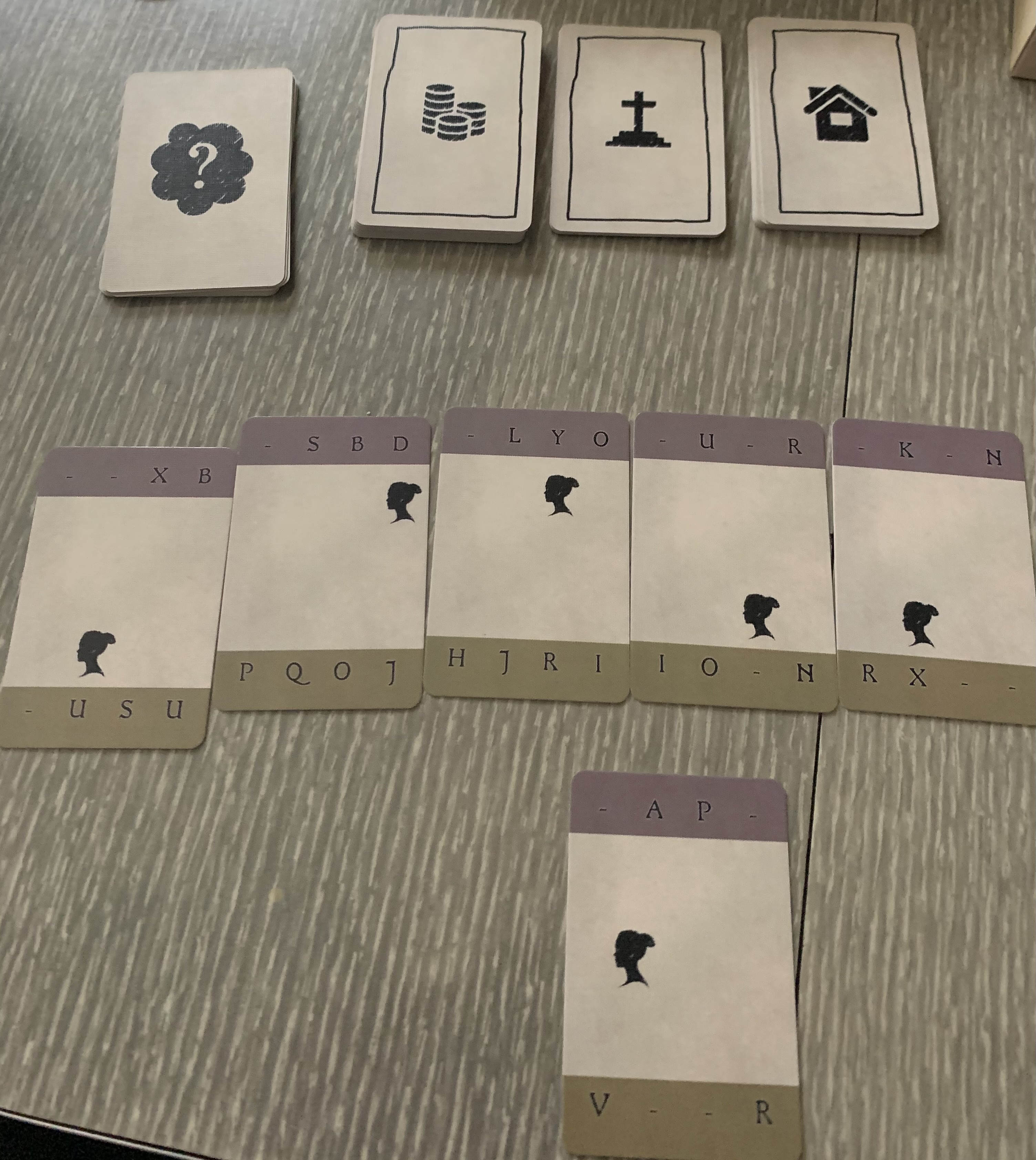






Basic details: 1 player; 30 minutes; beat-your-own-score solo mode
Date played: May 20, 2021
Gist of the game: In this game, you are tracking Shakespeare’s elusive muse that he dubbed the Dark Lady, and whose identity remains unknown, through London. You move throughout the city, searching locations for the Dark Lady. Once you think you have determined her defining characteristics, you must find her once more to verify you are correct.
There are a few different decks of cards used in this game. To begin the game, place the board in the middle of the play area and place the pawn at any location. The deduction tokens, with which you will build your profile of the Dark Lady’s characteristics, are placed by the board. The small deck of fog cards is shuffled and placed face down next to the board.
Next, assign the Dark Lady. To do this, shuffle the clue cards (featuring, on the face-up side, a picture of a woman, her name, her 3 (out of 7 possible) characteristics, and how many of her characteristics match the Dark Lady based on the suit of the Dark Lady, and, on the face-down side, a suit. There are 6 total suits and 2 clue cards per suit). Draw the top card (face down) from this deck and tuck it under the appropriate spot on the board. The clue card with the same suit as the Dark Lady is placed face down near the board with the location cards placed on top. Once you have received all the location cards by visiting all the locations on the board, this clue can be revealed to you. Clue cards may also be removed from the game in order to adjust the difficulty. The clue cards that remain form the clue deck. The clue cards are shuffled again and placed face up with the mask card placed on top, keeping the top clue card hidden.
For the Dark Lady’s stealth deck, choose one of the 8 letters displayed (top row for easier games, bottom row for harder games), and note its position (e.g., top leftmost, bottom 2nd from the right, etc.). For that position, you will then assemble the stealth cards alphabetically, discarding any that only have a dash for that location. Once the cards have been alphabetized for the position you have chosen, turn the cards face down so they display the location symbol and then cut (not shuffle) the deck at least once, but as many times as you wish. Then take the countdown card so that the number 2 is displayed right side up and place the card on the bottom of the stealth deck. Each time you pass through the deck you will lower the counter by 1, and you lose the game if you reveal the counter with 0 displayed.
During the game, you and the Dark Lady will take turns moving. The Dark Lady always moves first. Each of you can only move to locations adjacent to your current location. There are tokens for you to use to identify the Dark Lady’s possible positions. Each round, to move the Dark Lady, the top stealth card (i.e., the previous turn’s move) is moved to the bottom of the deck and the Lady moves to the revealed location(s).
On your turn, you can take one of the following actions: 1) move the pawn to an adjacent location; 2) search for the Dark Lady at your current location (either for a clue card or to reveal if your deductions are correct); 3) use a fog action card; or 4) take no action and move immediately to the Dark Lady’s next turn.
When you move the pawn, you may only move it to an adjacent location. If you have never been to that location, you receive the location card with a keyhole punched out for use when searching for the Dark Lady. Once you have received all the location cards, you can also reveal the clue card the location cards were previously covering.
To search for the Dark Lady, replace the current stealth card with a fog card. To do this, slide the fog card underneath the current stealth card without revealing the next stealth card (which reveals where the Lady will move next). If the current stealth card is already a fog card, you cannot perform a search. If there are no fog cards left for you to place in the stealth deck, you lose the game. Then, with fog card safely underneath, take the current stealth card and place it so that the location symbol faces you and the other side of the stealth card covers up the location/name on the location card (there is a quote on the other side of the location cards). Then, turn over these two cards so that you can see the Shakespeare quote and part of the stealth card through the keyhole. If the Dark Lady’s silhouette is visible in the keyhole, you can take the top card of the clue deck and reveal it. If you have enough clues to make your guess as to the identity of the Dark Lady, you can also check your guess once you’ve found her. If there is no silhouette, the Dark Lady is not at that location. Either way, discard that stealth card from the game and have the lady flee by advancing the stealth card a number of cards equal to the number of clue cards that have been revealed.
When encountering a fog card in the stealth deck, the lady will continue on her path, but you cannot search for her this turn (her whereabouts are a mystery). To use the fog card’s action, replace it with the top card of the fog deck (placing it underneath the current fog card without revealing the symbol on the next stealth card). and turn the current fog card over to reveal its action. Take the action and then, if applicable, place the card at the bottom of the fog deck. If you cannot take the action on the fog card, or you cannot replace the fog card with another fog card, you lose the game.
So, ways to lose: Run out of fog cards or be unable to take the action on a fog card. Or go through the stealth deck 3 times. Or be incorrect about any of her characteristics when you make your official guess.
If you successfully identify the lady after successfully searching for her, you can also tally your score. You earn 1 point for each card in the stealth deck on top of the countdown card. Multiply the number on the countdown card by the number of cards in the overall sequence (26 in a regular game). Add 2 points for each remaining card in the fog deck. Then make adjustments based on the difficulty of the game. Halve your score if you’re playing in training mode. Subtract 30 points if you played on easy mode. Add 5 points if you played on advanced mode. Add 5 points per discarded fog card in expert mode. This score then fits in a threshold with a Shakespearean theme: chimney sweeper, golden lad/girl, fair youth/maid, and immortal bard.
Color commentary: Oh, lawd. Why do I find myself drawn in concept to deduction games, when in practice I have the deductive skills of a peanut? (M here: Don’t sell yourself short. You are easily on the level of an almond.)
Also, I found the rules to be mostly incomprehensible. I don’t know if this is because they are actually mostly incomprehensible, or if I was just struggling to conceptualize things, but I had to resort to YouTube videos to figure out how to play, which is my very least favorite way to learn how to play games. It really bothers me when I can’t figure out how to play a game using just the rulebook. My worklife is basically spent making sense of oblique writing and it feels like a blow to my intellect when I can’t do the same in my hobby. This is only the 2nd game (Bottom of the 9th being the other) I’ve had to resort to YouTube for, though, so I suppose I should give myself a bit of a break. And the videos did make it much more clear, which I suppose is the important thing, but the lingering self-doubt from having to rely on them in the first place persists.
I was roughly as bad at the game as I expected to be. On both my playthroughs, I had a spate of unlucky searches and ran out of fog cards. On the first game, I had correctly determined 2/3 of the characteristics, and then did worse in the second game, only getting 1 characteristic correct. Nonetheless, it feels like a faster game than Sherlock Holmes Consulting Detective, and losing felt less embarrassing for some reason I can’t quite identify.
Thoughts M might have had if he had played/after reading my description: Boring theme. (Petra here: M’s too old to have grown up with Wishbone, so he never developed the taste for literature that I have. Sad, really, though forgivable.) The keyholes in the location cards are pretty neat, as is how they align with the stealth cards to know if your guess is correct. Overall, the game seem complicated and like I wouldn’t enjoy it very much. Then again, the process of deduction and trying to triangulate the Dark Lady’s characteristics seems like it could be interesting. Maybe I’ll join up as the other half of Team Hendriquist for a game sometime. In the meantime, I’m holding out for what Petra says is a Space Invaders-esque solo game that she’ll bust out and write about at some point this summer.
P rating: 6 (mostly because I’m finding it hard to imagine ever winning, which does make a game somewhat less appealing, especially when I’m the only player)
M rating (based on premise and description): 5